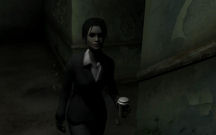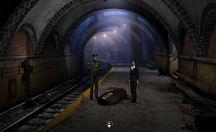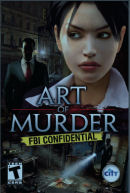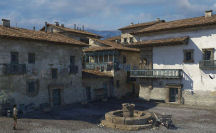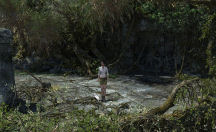Nicole Bonnet is a brand new Special Agent of the
Federal Bureau of Investigation and sheís itching to make an impact on the
world. Arriving at a run-down tenement for a stakeout, she is dismissed to
fetch coffee. Upon her return, she finds her partner dying from a gunshot
wound and a panicked run up the stairs to the roof shows a car speeding
away from the scene. Determined to find the killer, she is instead
assigned a serial murder case. Someone is killing influential citizens in
Manhattan, New York and -- like most serial killers -- is leaving clues by
the modus operandi. In this case, a ritualistic dagger is being used to
carve the victimsí hearts from their bodies, and ancient coins are
inserted in various orifices.
The investigation logically leads to a museum in an
effort to identify the dagger and talk to those who knew the victims,
accumulating any forensic evidence available. As Bonnet progresses with
her investigation, she finds links to Peru that convince her that
traveling there will shed light on why these particular victims have died.
Ignoring protocol and her own safety, the impetuous Bonnet hops a plane in
an effort to find a lost city that may allow her to uncover valuable
evidence.
Just a minute, you say. A female FBI Agent, a tenement,
coffee, a panicked run up some stairsÖThat opening scene is reminiscent of
the adventure game Still Life, isnít it? Even the office secretary
in this game resembles the coroner in Still Life. The initial
similarity between the two games is most unfortunate for this game, as it
suffers by comparison. It has none of the artful power to enthrall, the
dynamic characters, or the explosive score to thrill while you became a
willing participant as Still Life grabbed you and yanked you into
its world. Sort of like yearning to kiss a newfound love, and instead
having your elderly auntie step up for a peck on the cheek.
The Story
The story is actually quite good: a mystery to solve
that spans New York and Peru. Thank goodness the game had Peru after the
claustrophobic inside settings in New York. Peru comes alive with areas to
explore and evidence lurking around the next ancient ruin. I wish there
had been more time spent there, as it was the most enjoyable part of the
game.
Unfortunately, the plot of the game is full of great
gaping holes, as if chunks were left out due to budget constraints. Some
of the more interesting aspects of the story are related by dialogue
instead of being played out in the game. I like dialogue in games, but
even I was disturbed by this tendency to hear in a few sentences what I
would like to have seen and played through. This isnít helped by the
jejune conversations you have to hear, either. Although occasionally
witty, even the main character fails to make the player care about her and
her quest. Youíre never drawn into Bonnetís world, and you never forget
even for a moment that youíre playing a game.
When Iím playing a good game, I donít usually mind or
sometimes even notice a lack of other characters in scenes Ė my attention
is riveted upon the unfolding story. However, in some games such as this
one, it is all too painfully obvious that only the absolutely necessary
characters for the storyline are on the screen. I donít think itís a
spoiler to tell you that even Bonnetís partner is unavailable for most of
the game. Why even bother to have him in the story, except to add a
tedious puzzle? I recognize that budget constraints may force the hand of
the developers. However, much could be done in the way of character
development of those characters that do appear, rather than making them
shadowy cardboard figures.
Game Mechanics
This is a third person adventure game, point and click.
Moving your mouse over the screen will indicate icons, a left button
click for action and movement, and a right icon click for descriptive
information. The screens are static with no scrolling. A double click of
the left mouse button will make Bonnet run. In addition, there is a hint
key on the screen that can be selected to show areas of interest and
exits. There is the occasional item location that makes this feature
worthwhile and avoids a pixel hunt.
There are ample save spaces and game play is saved by
way of a picture depicting the location of the save. You can save at any
point outside of certain puzzles and cut scenes.
I encountered no glitches except for once having
out-of-sequence dialogue that made me think I hadnít solved a puzzle when
it was actually completed.
Graphics
Graphics and story are the strength of this game.
Although the cut scenes are choppy and somewhat grainy and the characters
are pictured too far away and shadowy for the most part, the landscape
scenery is lovely. When the game ventures to South America, it comes
alive. Cobblestone streets, a stone fountain, the lush foliage of the
jungle and the mysterious ancient ruins are rendered in loving detail.
Sound
The ambient sound is likewise well done, with
appropriate sounds according to the scene. The jungle sounds as a jungle
should; towns have engine sounds of vehicles, and so on. The characterís
footfalls are heard on different substances.
The musical score is instrumental and changes by scene.
I found it vaguely disturbing when I was trying to concentrate on the
game, and took my headphones off.
The voiceover work is mostly average, with a few voices
less than adequate. It becomes rather grating to hear Bonnet tell you for
the umpteenth time that what youíre attempting to do to utilize inventory
items is incorrect, when what is needed is a line of dialogue from someone
before you can do the very same action successfully.
Puzzles
The puzzles are mostly inventory based, with a few
simple logic puzzles as well. Theyíre well integrated into the story, and
a seasoned adventure game player will probably breeze through them. There
isnít anything you havenít seen before in some variation.
The game is very linear, and you canít leave an area of
the game until all puzzles are solved. Bonnet will indicate if thereís
something else that needs to be done. By the process of elimination, even
a new adventure game player will be able to solve this game through trial
and error.
For many puzzles it is clear what needs to be
accomplished, but as I said previously, a line of dialogue will have to be
elicited before the puzzle can be completed. This seemed a bit picayune.
You will encounter two puzzles where failure results in
a ďgame overĒ when the character can die. One of these is timed. The
biggest problem with this puzzle is that, unless you are really lucky,
youíre going to experience a ďgame overĒ at least once while you figure
out what is necessary for success.
There are, however, no mazes, sound, color or slider
puzzles.
Bits and Pieces
The game is on
DVD, so you must have a DVD drive to play it.
The disk has to
be in the drive for the game to play.
There are quite
a few instances of expletives, and at least one scene that contains gore.
The game is rated 16+.
Subtitles are
provided. A few of these have typographical errors.
Summary
I donít want to
give the impression that this is a bad game, because it isnít. Itís
pleasant enough to play. You most likely wonít shake your fist at the
screen, bemoaning the fact you bought it, nor will you probably feel the
urge to clasp it in a warm embrace and call it your child.
-
Third person
point and click.
-
Inventory and
logic puzzles.
-
One timed puzzle
in which your character can die.
-
Ample saves, and
you can save almost anywhere.
-
An interesting
mystery with mediocre dialogue.
-
Scenery graphics
are well done.
Grade: B-
